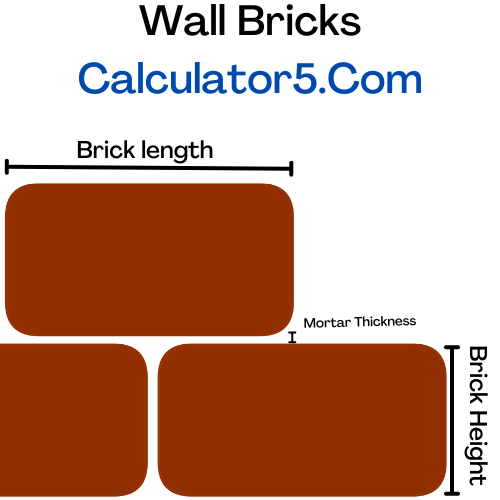Wall Bricks Calculator
Wall Bricks Calculator
Example
Wall Dimensions:
- Wall Length: 10 feet
- Wall Height: 8 feet
- Wall Thickness: 6 inches
Brick Dimensions:
- Brick Length: 8 inches
- Brick Height: 4 inches
- Brick Thickness: 4 inches
Cement Thickness: 0.5 inches
Calculation:
- Convert all dimensions to feet:
- Wall Thickness: 6 inches = 0.5 feet
- Brick Length: 8 inches + 0.5 inches (cement) = 8.5 inches = 0.708 feet
- Brick Height: 4 inches + 0.5 inches (cement) = 4.5 inches = 0.375 feet
- Brick Thickness: 4 inches + 0.5 inches (cement) = 4.5 inches = 0.375 feet
- Calculate Wall Volume: 10 ft (length) × 8 ft (height) × 0.5 ft (thickness) = 40 cubic feet
- Calculate Brick Volume: 0.708 ft × 0.375 ft × 0.375 ft = 0.099 cubic feet
- Number of Bricks: 40 ÷ 0.099 = 404 bricks (rounded up)
Result: You need approximately 404 bricks to build the wall.
The Wall Bricks Calculator is a user-friendly tool designed to help you estimate the number of bricks required to build a wall. By inputting the wall dimensions, brick size, cement thickness, and wall thickness, the calculator provides an accurate count of bricks needed, saving time and effort in construction planning.
This is the best wall bricks calculator for uk, usa, austrailia, india, pakistan, gulf, europe, and all other countries without erros. Becuase you and enter your own values.
You can also calculate blocks for a wall or any other type or size of bricks, blocks, slabs, stones, fly ash, concrete bricks or any of your custom size bricks for construction of a wall, house, room, basement, roof tiles etc.
Related Calculators:
How This Calculator Works

Accounting for Cement Thickness
To account for the cement thickness (mortar thickness) between bricks, we need to adjust the brick dimensions to include the mortar. This ensures that the total volume occupied by both bricks and mortar is considered in the calculation.
Updated Formula
The formula now includes the cement thickness:
\[ \text{Number of Bricks} = \frac{\text{Wall Volume}}{\text{Adjusted Brick Volume}} \]
Adjusted Brick Dimensions
The dimensions of the brick are increased by the cement thickness on all sides:
Adjusted Brick Volume
The volume of a single brick, including the mortar, is calculated using the adjusted dimensions:
Wall Volume
The volume of the wall remains the same:
\[ \text{Wall Volume} = \text{Wall Length (feet)} \times \text{Wall Height (feet)} \times \text{Wall Thickness (feet)} \]
Number of Bricks
The total number of bricks required is the wall volume divided by the adjusted brick volume. The result is
rounded up
using Math.ceil().
Best Uses and Benefits of Wall Bricks Calculator
Uses
- Construction Planning: Ideal for architects, engineers, and builders to plan construction projects.
- Material Procurement: Helps in purchasing the correct number of bricks, avoiding shortages or excess.
- Budgeting: Assists in creating accurate budgets for construction projects.
- DIY Projects: Useful for homeowners or DIY enthusiasts working on small-scale projects like garden walls or home renovations.
- Educational Purposes: Helps students and learners understand the relationship between volume and material requirements.
Benefits
- Accuracy: Eliminates manual calculation errors, ensuring precise results.
- Time-Saving: Quickly calculates the number of bricks required, saving time for builders and contractors.
- Cost Estimation: Helps in estimating the cost of materials by knowing the exact number of bricks needed.
- User-Friendly: Simple and intuitive interface makes it easy for anyone to use.
- Versatility: Can be used for walls of varying thicknesses and designs.



